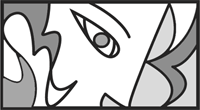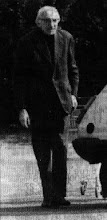Lacan considers the question of the Trinity in relation to Borromean rings or knots, and he takes the issue up in Seminar 23, Le sinthome (1975-1976). I propose to look at the account given of this seminar by Roberto Harari in How James Joyce Made His Name (trans. Luke Thurston, Other Press, New York, 2002). It will be remembered that rings of this kind had been used in the Middle Ages to symbolise the Trinity, though neither Lacan nor Harari refers to this fact. For Lacan, the rings serve to engage a certain relation between the Real, Symbolic and Imaginary (R. S. I). Roman Catholicism is, on this view, ‘the only true religion’ inasmuch as by proposing the order of the Father, the Son and the Holy Spirit it exemplifies the triadic order of R.S.I. Harari cites (pp. 92-94) relevant passages from Portrait of the Artist as a Young Man and from Reinach’s Orpheus to justify the Catholic doctrine of the filioque, to which R.S.I. would seem to lend support. As Lacan presents the threefold ring, the third ring, which links the other two into a trinity, is identified with the Holy Spirit, which thus proceeds from the Father and the Son.
Lacan, however, does not remain with the threefold ring. He develops a ring of four elements (see Harari, Figure 11, p. 61), a quadruple Borromean ring, fuller details of which Harari sets out on page 61 and elsewhere. To develop such a ring, it is necessary to untie the original three rings, which had six crossing points, in order to include one more ring, which results in a figure with fourteen crossing points (as laid out on a flat surface like a page). If you want to retie you must first untie. This fourth ring, this fourth order, corresponds to the sinthome. According to Lacan, what Joyce achieved was, as Harari has it, ‘nothing less than a mise-en-scène of this quadruple knot’. The place, so to speak, of the sinthome is outside and yet within R.S.I., and it is from this position that R.S.I. may approached. That the manifestation of this position is what takes place in Joyce’s later writing is the thrust of Seminar 23 and of Harari’s book. I will do no more that suggest here that something not dissimilar may be found in the language of Wittgenstein’s considerations of aspect seeing and the experience of meaning. At the very least, it seems likely that an illuminating comparison may be drawn between these writers.
So far as the Trinity is concerned, on Lacan’s showing, this fourth order is exemplified by the figure of Mary, who appears as that to which the three rings refer themselves. It is though her intercession that one may approach the divine persons. However, a problem arises at this point, I believe. Mary, her blessedness and sanctity notwithstanding, is not divine. The fourth ring, however, is a ring like the other three: it has, so to speak, the same nature. There is, at any rate, nothing to distinguish it from the others, apart from the route it follows in relation to them. (In constructing such a figure, all one needs are four lengths of string which can come from the same ball.) In short, the fourth order, if there is to be a correlation with the Trinity, must also be divine, uncreated. This represents an impasse for Lacan’s argument, based as it is on Catholic doctrine. No such problem arises for the Orthodox tradition, however, despite the dismissal of it in Harari’s book. The fourth order is that of the uncreated grace which flows eternally from the Trinity, that which manifested itself on Mount Tabor, in the light of the Transfiguration. It was just such a theology of uncreated grace, of the uncreated energies, that Gregory Palamas developed in Constantinople after the schism. Palamite theology is taken by Orthodox theologians and by the Church itself as true to the Patristic experience: the Feast of Orthodoxy celebrated during Lent is a celebration of Palamas and his thought. An account of these matters is to be found in Vladimir Lossky, virtually passim, and in the work of Bishop Kallistos. (There are of course many other modern Orthodox theologians who have characterised the issues at stake.)
Lacan imposes on his rings a temporal succession. First, the Father (ring one), then the Son (ring two) and then the Holy Spirit (ring three), which holds the first two together and thus may be said to proceed from the Father and the Son. There is, of course, no doctrine of uncreated grace in Catholicism, hence the role of the Mother of God in explaining or parsing the fourfold set of rings. On the picture I am presenting (and it is a picture, no more), the fourfold set operates retroactively, a procedure that elsewhere is crucial to Lacan (see the graphs of desire, for example, or the discussion of logical time). It is possible to approach the Trinity, if ‘approach’ is the word I need, only by way of the uncreated grace of the Spirit: the Trinity is not accessible ‘in itself’. It is thus the fourth ring that constitutes the whole order of rings as fourfold. One conclusion to be drawn from this is that, if we stick with Lacan, the life of the Christian has more than a little in common with that of one who identifies with the sinthome, the holy man, Saint Thomas, etc. The sinthome is to be distinguished from the symptom, inasmuch as in it one achieves, or is seized by, an identification with one’s singularity: ‘what is in me more than I am myself’.
The Virtues of Knowledge
7 years ago


